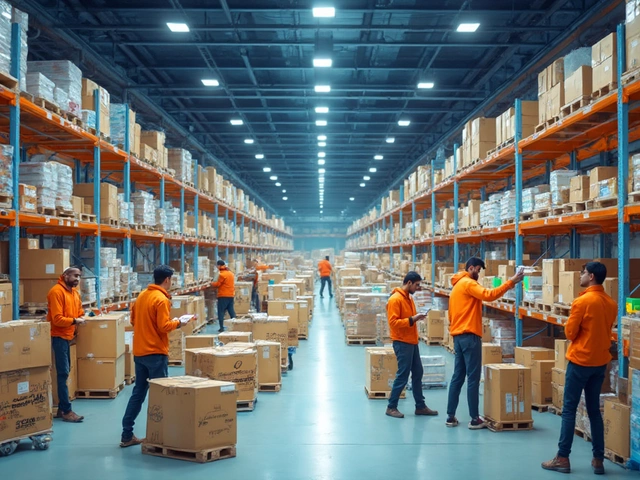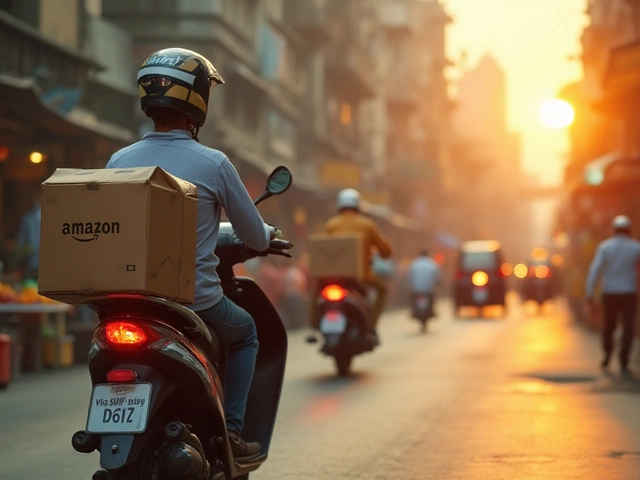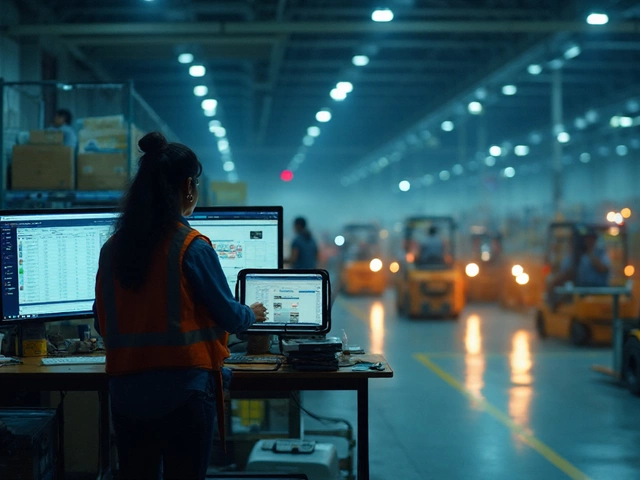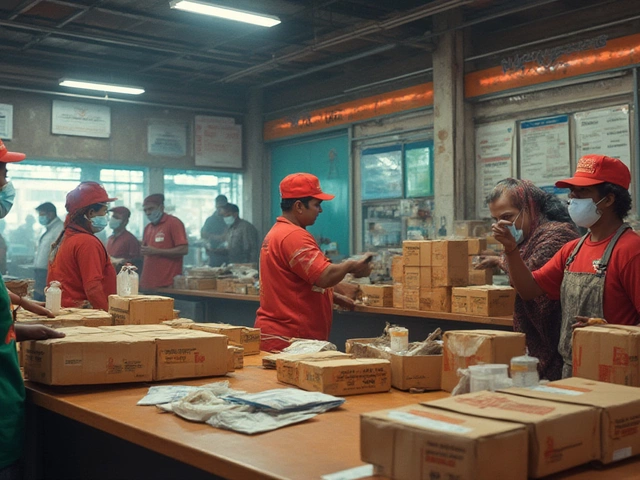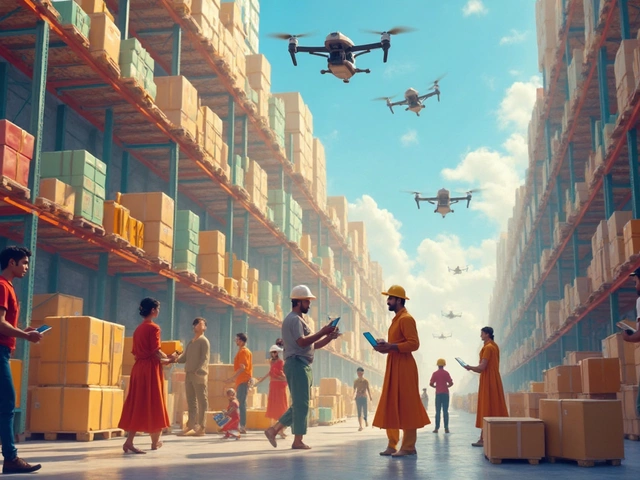Last mile delivery is the crucial stage where the package finally reaches the customer's hands, but it's also the toughest part of the journey. Why? Think about urban traffic congestion, unpredictable weather, or miscommunication leading to a missed delivery. These hiccups turn into significant risks for companies yearning to satisfy customers and maintain smooth operations. Ever had a package take a detour to the Bermuda Triangle? That's what it feels like when things go astray!
Understanding these challenges is key for businesses. A missing package isn't just a temporary glitch—it's a hit to your brand's reputation and trust. Imagine your favorite pizza place messing up your order one too many times; you'd probably switch o find another, right? In the same way, businesses need to get the delivery right to keep their customers happy and loyal. But how do you identify and tackle these risks effectively?
- Defining Last Mile Delivery
- Common Risks Faced in Last Mile Delivery
- Impact of Delivery Risks on Businesses
- Strategies to Mitigate Last Mile Delivery Risks
- Future Trends in Last Mile Delivery
Defining Last Mile Delivery
The term last mile delivery refers to the final stretch of a product's journey from a distribution hub to the customer's front door. It sounds simple, right? Yet, this last segment is a beast of its own, making up a whopping 53% of the total delivery cost for companies, according to industry research. No wonder businesses are always sweating about it!
The last mile isn't just about getting a package from point A to B. It's about making sure it happens with speed, efficiency, and accuracy. Imagine waiting for a package, only for it to show up late or at the wrong address. Frustrating, right? For companies, that split second of disappointment could mean a lost customer forever.
What's Included in Last Mile Delivery?
At its core, this process involves several steps: picking up items from a centralized location, organizing them for delivery, and ensuring they reach customers without a hitch. Here's what it typically covers:
- Warehouse to Delivery Hub: Goods are transported from a central warehouse to local delivery hubs.
- Sorting and Dispatching: Packages get sorted based on delivery routes and times.
- Actual Delivery: Couriers or delivery drivers transport goods to the intended destination.
- Proof of Delivery: Confirmation that the package has been received by the customer.
With logistics challenges like traffic bottlenecks and unforeseen delays complicating things, adapting strategies like optimized routing and real-time tracking is crucial. So, whether you're waiting on a spring outfit or the latest gadget, there's a lot that happens behind the scenes!
Common Risks Faced in Last Mile Delivery
When it comes to last mile delivery, businesses need to watch out for a handful of challenges. For starters, there's the menace of delivery delays. Traffic jams, bad weather, or even road closures can throw a wrench in the delivery schedule, leaving customers tapping their feet waiting for their packages.
Lost or Misplaced Packages
Another headache is dealing with lost packages, which can happen for a number of reasons. Sometimes delivery personnel get lost or deliver it to the wrong address. Remember that time when you got a neighbor's mail by mistake? It's like that but on a larger and costlier scale for businesses.
High Delivery Costs
Costs also tend to balloon during this final leg of the delivery process. Fuel, labor, and even customer returns can drive up expenses, impacting the overall profit margin. Many companies are now looking at eco-friendly vehicles and optimizing routes to tackle this.
Customer Dissatisfaction
Let’s not forget how these issues directly impact customer satisfaction. Waiting longer for a package or receiving the wrong item can turn a loyal customer into a grumbling one. And in today's fast-paced world, people aren't shy to express their frustrations on social media, which can lead to negative brand exposure.
According to a recent survey:
| Risk | Percentage of Businesses Affected |
|---|---|
| Delivery Delays | 62% |
| High Delivery Costs | 53% |
| Customer Dissatisfaction | 49% |
These figures highlight the importance for businesses to not only identify these risks but also to have strong strategies in place to mitigate them. Being proactive can save a lot of headaches down the road.

Impact of Delivery Risks on Businesses
The challenges of last mile delivery aren't just annoying—they can genuinely mess up a business's game plan. You've got companies bustling to get packages into their customers' hands, but when things go wrong, it's not just eggshells that get cracked.
Customer Satisfaction Takes a Dive
When a delivery runs late, is misdelivered, or—worst of all—gets lost, customers aren’t exactly forgiving. Their patience wears thin, and trust starts to fade. We've talked about that pizza delivery, right? One too many fails, and your customers are already checking out the competition. Keeping them happy through efficient and accurate delivery keeps them from wandering off.
Financial Drain
Every mishap in the delivery risk zone can bleed into the bottom line. Extra costs pile up when businesses need to redeliver or process refunds, which can be painfully repetitive. Add to that, any discrepancies in delivery can lead to potential loss of sales. Nobody wants to keep losing cash for no good reason, especially when it's avoidable!
Reputation and Trust
In a world where reviews can swing dinners and TV shows, businesses can't afford negative press from botched deliveries. It's not rocket science to know that word spreads fast—one or two bad raps can kick a reputation down the hole.
Example of Potential Impacts
| Risk | Impact |
|---|---|
| Lost Packages | Decrease in customer trust, refunds, products replaced |
| Delayed Deliveries | Customer dissatisfaction, potential loss of future sales |
| Rising Costs | Increased expenditures from redelivers or alternative solutions |
Ultimately, addressing logistics challenges is crucial for ensuring a business can keep up with customer demands and thrive in a competitive market. Smart decisions today can prevent headaches tomorrow. It might feel like spinning plates sometimes, but staying ahead of these risks ensures smoother operations and happy customers all around.
Strategies to Mitigate Last Mile Delivery Risks
Tackling the risks in last mile delivery means having a solid game plan. Businesses need to be proactive about potential mishaps and ready to roll with the punches. Let's explore some key strategies that could make this part of logistics less bumpy.
Invest in Technology
Embracing technology can seriously boost efficiency. Using real-time tracking systems lets companies and customers keep tabs on where a package is at any time. Who doesn't love knowing their package hasn't decided to take a scenic route? Cloud-based software can also provide valuable insights by analyzing delivery data to identify patterns and problems before they snowball.
Smart Route Planning
Think of smart route planning like having a GPS that's not only taking the fastest route but also the one with the least chance of causing delays. Advanced algorithms can take traffic, road conditions, and even weather forecasts into account to chart the optimal path for delivery vehicles. The result? Fewer delays and happier customers.
Partner with Local Couriers
Teaming up with local couriers who know the area like the back of their hand can be a lifesaver. These partnerships allow you to benefit from their experience, local knowledge, and established delivery networks. Plus, they might just know the best pizza joint for a driver grab-n-go snack!
Improve Communication
Nothing's worse than mixed signals leading to a missed delivery. Keeping good communication with the customer is crucial. Automated delivery updates via text or email can make life easier for everyone involved. It keeps the customer in the loop and helps the delivery process flow smoothly.
Flexibility is Key
Offering flexible delivery options like specific time slots or pickup locations can help reduce the chances of those dreaded 'sorry we missed you' cards. It’s a win-win — customers get what they want, when they want it, and businesses lower the risk of repeat delivery attempts.

Future Trends in Last Mile Delivery
Let's peek into the future of last mile delivery—a world where packages practically fly to your doorstep. Tech is reshaping how we think about getting stuff to customers quickly and efficiently. Ever heard of drones delivering your online shopping? That's becoming a thing, step by step!
Drone Deliveries
Drones are set to revolutionize how we perceive delivery, zipping over traffic with no problem. Companies like Amazon are already testing them. Jeff Wilke, former CEO of Amazon Worldwide Consumer, said,
"We're excited about Prime Air delivering packages to customers in 30 minutes or less."With drones taking to the skies, shorter delivery times and less congestion could become the norm for last mile delivery.
Autonomous Vehicles
Autonomous vehicles are also gaining traction. Think of them as driverless delivery vans roaming city streets. They promise fewer errors and lower costs. Imagine never worrying about a grumpy delivery driver again!
Sustainable Delivery Methods
Then there's the focus on eco-friendly delivery. Electric bikes and vehicles reduce carbon footprints, making deliveries green. Consumers are increasingly eco-conscious, and businesses are catching on.
Hyperlocal Warehousing
Storage facilities placed closer to customers accelerate delivery risk times. Companies use small urban warehouses to store goods near demand hotspots, getting packages out faster and more efficiently.
Real-time Tracking Technology
As transparency and security gain importance, real-time tracking becomes essential. Customers want to know exactly where their package is, every step of the way. Advanced GPS and smart dashboards are being implemented everywhere.
Check out this cool table for some stats on trends:
| Trend | Estimated Growth Rate (2025-2030) |
|---|---|
| Drone Deliveries | 20% annually |
| Autonomous Vehicles | 15% annually |
| Sustainable Methods | 30% increase in adoption rate |
Change is shaping the future of logistics, so keeping up is a must. Businesses diving into these innovations could gain the edge, meeting customer demands with unmatched flexibility and speed. Got questions? The key question is—how soon are we getting flying deliveries?

